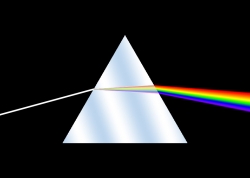Light is a speedaholic. It loves speed! It wants to move as fast as it can through anything that gets in its way so it can continue to shoot through the universe. Light normally moves in straight lines. But when it reaches something new, like a piece of glass or water, it will change direction to find the fastest way through. Just like you might change directions when you run from an empty field into a crowd. When light exits, it will bend because it's free to move how it wants to. This is called refraction.
Have you ever tried to run against the wind? It's hard, right? It pushes against you. But if you run at an angle you can keep moving fast. How about running through water? Even harder, right? The water grabs your feet and holds your body back. Like you, there are some things that light can pass through more easily than others. Light will move more quickly or slowly, straight or at an angle depending on its medium. And no, that's not the shirt size between large and small. Medium is another word for the substance that something moves through. Light and glass, air and water -- these are different mediums that light uses to move. Refraction happens when light moves from one of these to another, say from water to air. It's this change that makes light bend.

Rainbows, when water and light find a happy medium.
Yathin S Krishnappa, CC BY-SA 3.0 , via Wikimedia Commons
You can run through a screen door much more easily than a wooden door. This isn't a science experiment. Please don't try it. Like you, the easiest things for light to move through are the ones that are clear or transparent. When something is transparent, it means you can see through it. Have you ever shined a light through a glass of water and then tried shining one through a glass of milk? The light shines clear and bright through the water glass. Can you see the light bend? Try filling a clear glass with water and then sticking a pencil in at an angle. The light from the pencil will bend and it will look like it's made of rubber.
So what is it like to be a bending beam of light? Have you ever pushed your way through a crowded place to get to an exit? You have to step and weave around people. You'll probably need to go in a different direction than a straight line in order to get where you're going. Once you reach the exit, you are free to move quickly and in any direction. Like you, light wants to find the fastest way through! In water, light has to move at an angle to get through. When it reaches the air, it will move in a more straight path. Science uses a number called the index of refraction to measure how much light speeds up or slows down when entering a new space. It measures that moment when you burst out of the exit and are free to move quickly.

Prisms, not much use on a dark night.
See page for author, CC SA 1.0 , via Wikimedia Commons
Some things can only bend so much before they break, and light is no different. But when light breaks, something beautiful happens. The best way to break light is with a prism. A prism is a glass triangle with long, rectangle sides that can split white light into different colors. Because of the way it's shaped, it will bend light and then immediately bend it again, making it break up into smaller parts, showing you a complete rainbow! White light has all the colors inside it "" red, orange, yellow, green, blue, indigo, and violet. Each color bends just a little more than the last. Red bends the least and violet the most. So, when light enters a prism and is bent and then bent again, the colors separate like a rainbow fan. But by holding a second prism up to the rainbow, you can put the colors back together into a single beam of white light.
Picture a race with your friends. You move through a windy field, through a pool, across an open lawn, and then through a crowded building. In order to find the way through, you have to move in all different directions, sometimes slowly, sometimes quickly. That's what it's like for light to move through our world . . . just millions of times faster.
References:
Hyperphysics. "Refraction of Light" GSU, 2000.
<http://hyperphysics.phy-astr.gsu.edu/hbase/geoopt/refr.html>
How Stuff Works. "How Vision Works""Refraction" How Stuff Works, 2009. < http://science.howstuffworks.com/environmental/life/human-biology/eye6.htm>
eHow. "How Prisms Work" eHow, 2010.
< http://www.ehow.com/how-does_4965588_prisms-work.html>
How Stuff Works. "What Causes a Rainbow" How Stuff Works, 2011. < http://science.howstuffworks.com/nature/climate-weather/atmospheric/question41.htm>